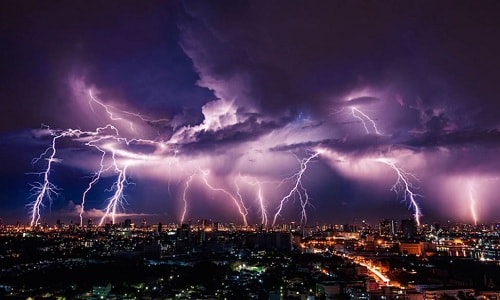Lightning triggers nuclear reaction in storm
Japanese researchers have discovered evidence that thunderstorms trigger nuclear reactions in the atmosphere.
 |
| Lightning produces antiparticles, leading to natural nuclear reactions. Illustration: Vasin Lee. |
In a study published yesterday in the journal Nature,physicistTeruaki Enotoat Kyoto University, Japan, proved that lightning acts as a natural particle accelerator to trigger nuclear reactions in the atmosphere, according to Live Science.
The results of Enoto and his colleagues' research confirmed speculations about this phenomenon that had been made in 1925. At that time, researchers hypothesized that energetic radioactive particles could pass through the thunder of a thunderstorm. These particles emitted energy at specific wavelengths. Enoto's team was the first to identify those wavelengths.
When lightning strikes, electrons are shot at super-speed between a cloud and the Earth’s surface or between two clouds, but they don’t travel through empty space. Along the way, they repeatedly collide with gas molecules in the atmosphere. These collisions heat the gas molecules to extremes, causing them to turn into a plasma state and glow with blackbody radiation, a type of electromagnetic radiation emitted by opaque objects.
Humans can see some of that blinding light as a flash of lightning. But the emission also occurs in the form of waves, including X-rays and gamma rays, beyond the ability of the naked eye to observe.
Enoto's research shows that these invisible energetic rays, especially gamma rays, knock outneutrons from moleculesNitrogen and oxygen in the surrounding air combine to form nuclear fission. A nitrogen nucleus with 14 neutrons is quite stable, but when it loses a neutron, it becomes nitrogen 13 (N-13), a less stable radioactive isotope. The same thing happens with oxygen, resulting in the isotope oxygen 15 (O-15).
All the N-13 and O-15 molecules decayed rapidly afterward. Each unstable isotope emitted a neutrino and a positron. Both are elementary particles with strange properties. The neutrinos flew so far away that they were almost undetectable. But the positrons, the antiparticles of electrons, continued to collide with electrons in the air. When a pair of particles and antiparticles collided, they annihilated in an instant.
In the study, Enoto and his colleagues used radiation detectors installed at the Kashiwazaki-Kariwa nuclear power station in Niigata, along the Sea of Japan. During a thunderstorm in February this year, the team detected intense radiation from offshore lightning, including a brief gamma ray flash followed by a longer gamma ray with an energy of 0.511 megaelectron volts (MeV). This is the energy level typically seen from positrons and electrons after a nuclear reaction.
"This gamma ray is a definitive proof of positron-electron annihilation, which indicates that photonuclear reactions can be triggered by thunderstorms," physicist Leonid Babich of the Russian Federal Nuclear Center commented on the research results.
According to VNE
| RELATED NEWS |
|---|



.jpg)
